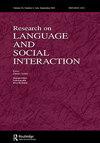将序列与[That's+Wh Clause]格式联系在一起:论会话中的(回溯)序列转折
IF 2.1
1区 文学
Q1 COMMUNICATION
引用次数: 3
摘要
本文探讨了一种序列组织现象,这种现象是由于使用了一种松散的可指定的转弯格式(即+ wh-从句)来启动(下一个)序列,同时又连接回先前的转弯。使用这种做法可以创建一个连续的结合点,即一个序列和下一个序列之间的轴心式联系。在第三个位置,这样的节点通过将后者呈现为局部发生,从而实现从一个序列到下一个序列的无缝顺序转换。然而,该实践也可以部署在第二位置,以启动先前的行动没有相关或没有提供的行动,并显示其自身的响应相关性。然后,顺序节点变成了反向顺序的特征:它们改变了正在进行的序列的投影轨迹,并创建了连锁的顺序结构。这些发现强调了顺序是实践,同时指出了未充分研究的捆绑和顺序之间的相互关系。数据是英文的。本文章由计算机程序翻译,如有差异,请以英文原文为准。
Tying Sequences Together with the [That’s + Wh-Clause] Format: On (Retro-)Sequential Junctures in Conversation
ABSTRACT This article explores a sequence organizational phenomenon that results from the use of a loosely specifiable turn format (viz., That’s + wh-clause) for launching (next) sequences while at the same time connecting back to a prior turn. Using this practice creates a sequential juncture, i.e., a pivot-like nexus between one sequence and a next. In third position, such junctures serve to accomplish seamless sequential transitions from one sequence into a next by presenting the latter as locally occasioned. The practice may, however, also be deployed in second position to launch actions that have not been made relevant or provided for by the preceding action and exhibit response relevance themselves. The sequential junctures then become retro-sequential in character: They transform the projected trajectory of the sequence in progress and create interlocking sequential structures. These findings highlight that sequence is practice, while pointing to understudied interconnections between tying and sequentiality. Data are in English.
求助全文
通过发布文献求助,成功后即可免费获取论文全文。
去求助
来源期刊
CiteScore
7.30
自引率
7.40%
发文量
20
期刊介绍:
The journal publishes the highest quality empirical and theoretical research bearing on language as it is used in interaction. Researchers in communication, discourse analysis, conversation analysis, linguistic anthropology and ethnography are likely to be the most active contributors, but we welcome submission of articles from the broad range of interaction researchers. Published papers will normally involve the close analysis of naturally-occurring interaction. The journal is also open to theoretical essays, and to quantitative studies where these are tied closely to the results of naturalistic observation.

 求助内容:
求助内容: 应助结果提醒方式:
应助结果提醒方式:


